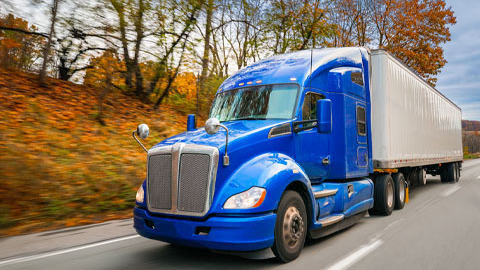Using ADAS Technology to Help Reduce Truck Crashes


Advanced Driver Assistance Systems (ADAS) are standard equipment on many commercial trucks because they help drivers avoid crashes.
Accident data shows that approximately 29% of accidents are rear-end collisions.1 That’s just one example where driver assistance technologies provide the potential to reduce traffic crashes each year.2 Research suggests that ADAS can play an important role in trucking safety.
ADAS use sensors and cameras to check their truck’s surroundings. When a potential hazard presents itself, the ADAS technology goes to work. Some of the features allow the driver to take corrective action such as braking or steering. Other features are automatic.
Some of the common features of ADAS include:
- Automatic emergency braking.
- Adaptive cruise control.
- Lane departure warning.
- Blind spot monitoring.
For ADAS to help reduce crashes, drivers must use them properly as a safety device. This begins with understanding how they work and that they can help avoid collisions.
How can ADAS technology training help truck drivers?
ADAS technology training can help truck drivers in several ways. First, it can emphasize that this technology is a helpful driving tool and not a replacement for in-cab operators and safe driving practices.
“Good safe-driving techniques are key,” said Anthony Slamar, a Northland Risk Control transportation specialist. “Above everything else, the driver is the most important safety feature.”
Second, it can help ensure that drivers understand and attain a level of comfort with the technology.
Lastly, it can help to identify some of the potential pitfalls of using ADAS. If drivers rely too heavily on ADAS, for example, it may lead to distracted driving issues. Discussing the issue is a good way to remind drivers of the key distractions that can impair safe driving. It is also a good way to reinforce an overall safety culture and help keep best practices at the top of their minds.
ADAS technology’s effectiveness in loss prevention
As truck drivers log more time on the road using ADAS technology, there are more real-life examples demonstrating its value. ADAS have helped prevent losses and bad situations from becoming worse. That said, improvement of the technology is ongoing.
Blind spot monitoring was developed to help reduce sideswipe accidents. This is a common risk that the truck driver faces – the potential to strike smaller vehicles when changing lanes. However, these incidents are on the decline with the implementation of this ADAS technology.3
While they cannot prevent all accidents, ADAS may be helpful in reducing those accidents that do occur.
ADAS may also help boost driver productivity. A driver who avoids a crash due to ADAS doesn’t have to pull over to take part in accident investigations. That’s lost time that can have a negative impact on the trucking company’s business. Smooth, accident-free driving helps keep a company’s truck on the road and earning.
Is your fleet ready for ADAS?
Introducing ADAS technology into trucking operations can add another layer of safety. Like most tech tools, ADAS are designed to help do a job more safely, but they don’t do it alone. Commitment to safety is critical, and Northland Risk Control can help trucking businesses integrate a variety of safety best practices into their operations.
Talk to your Northland agent to learn how the Northland Risk Control team can help you integrate ADAS technology and tailor a safety program to your business.
Sources
1https://natlawreview.com/article/facts-about-rear-end-accidents
2https://www.nhtsa.gov/vehicle-safety/driver-assistance-technologies#61936
3https://www.itskrs.its.dot.gov/2019-b01384#:~:text=Blind%20spot%20warning%20technology%20has,to%2Drear%20crashes%20with%20injuries




